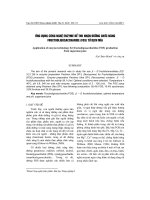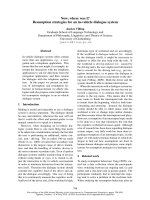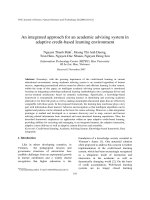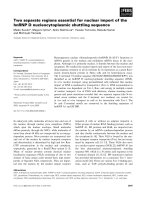Call for an enzyme genomics initiative Peter D Karp potx
Bạn đang xem bản rút gọn của tài liệu. Xem và tải ngay bản đầy đủ của tài liệu tại đây (65.29 KB, 3 trang )
Genome Biology 2004, 5:401
comment
reviews
reports
deposited research
interactions
information
refereed research
Open letter
Call for an enzyme genomics initiative
Peter D Karp
Address: Bioinformatics Research Group, SRI International, 333 Ravenswood Ave, Menlo Park, CA 94025, USA. E-mail:
Published: 30 July 2004
Genome Biology 2004, 5:401
The electronic version of this article is the complete one and can be
found online at />I propose an Enzyme Genomics Initia-
tive, the goal of which is to obtain at
least one protein sequence for each
enzyme that has previously been charac-
terized biochemically. There are 1,437
enzyme activities for which Enzyme
Commission (EC) numbers have been
assigned but no sequence can be found
in public protein-sequence databases.
A recent essay by Roberts [1] called for
an effort by the scientific community to
experimentally determine functions for
unidentified genes in microbial
genomes. Put another way, the essay
focused on sequences with no associ-
ated function. Here, I explore the
inverse problem: functions with no
associated sequence. I propose an
Enzyme Genomics project whose goal
is to find at least one amino-acid
sequence for every biochemically char-
acterized enzyme activity for which
there is currently no known sequence.
Roberts identifies three classes of
genes whose functions would be most
valuable to obtain: hypothetical genes
with homologs in multiple organisms
(conserved hypotheticals), non-con-
served hypothetical genes, and misan-
notated genes. Roberts proposes that a
consortium of bioinformaticians post
functional predictions for these genes
to a central website. Biologists would
then choose candidates and test the
predicted functions in the lab, with
results - both positive and negative -
added to the same website. Roberts
also proposes that the initial list of
target genes be chosen from an experi-
mentally tractable organism such as
Escherichia coli, with the recognition
that some experiments might be per-
formed on homologs from other
organisms.
My proposal for an Enzyme Genomics
Initiative is based on a different part of
the gap between genomics and bio-
chemical function, and I suggest it as a
fourth priority area in addition to the
three suggested by Roberts. Elucida-
tion of protein sequences correspond-
ing to enzyme activities is important
because of the many applications of
metabolic enzymes in areas ranging
from metabolic engineering to anti-
microbial drug discovery to metabolic
diseases. Finding enzyme sequences
may also be easier than the projects
listed by Roberts, because in many
cases significant biochemical knowl-
edge about these enzymes (such as
purification procedures and assays) is
already in hand.
Consider two implications of the many
characterized enzymes for which no
sequence exists. We cannot identify in
a newly sequenced genome any of the
enzyme activities for which no
sequence exists, because to identify
these enzyme functions in a new
genome we require at least one
sequence in a public sequence database
to match against in the newly
sequenced genome. This consideration
limits both the completeness of
genome annotations and our ability to
infer the metabolic pathway complement
of an organism from its genome using
methods such as the PathoLogic
program [2]. A second implication is
that we cannot genetically engineer any
of these enzymes into a new organism
to accomplish a metabolic engineering
goal, because we do not know which
gene(s) to insert to provide the needed
enzyme activity.
No sequence has been
determined for many known
enzymes
Consider the enzyme D-mannitol
oxidase, which was isolated from the
snail digestive gland and assigned the
EC number 1.1.3.40. Although the
activity of this enzyme was character-
ized biochemically and published in
1986 [3], no amino-acid or nucleotide
sequences are available for this enzyme
in the public sequence databases.
As shown by the following analysis, for
38% of the enzyme activities that have
been characterized biochemically, no
corresponding amino-acid sequence is
known. Consider the Enzyme Nomen-
clature System of the International
Union of Biochemistry and Molecular
Biology (commonly called the EC
system), which is a catalog of many (but
not all) biochemically characterized
enzyme activities. For what fraction of
© 2004 Karp; licensee BioMed Central Ltd. This is an Open Access article: verbatim copying and redistribution of this article are permitted in all media for
any purpose, provided this notice is preserved along with the article's original URL.
Open Access
401.2 Genome Biology 2004, Volume 5, Issue 8, Article 501 Karp
Genome Biology 2004, 5:401
those enzyme activities is at least one
sequence known in a public protein
sequence database? Unless otherwise
stated, all of the following statistics
refer to database versions available as
of December 2003, and were calculated
with the help of SRI’s BioWarehouse
system for integration of bioinformat-
ics databases.
The ENZYME database is an electronic
version of the EC system [4]. Version
33.0 of ENZYME contains 4,208 dis-
tinct EC numbers, of which 472 have
been deleted or transferred to new
numbers; it therefore lists 3,736 differ-
ent biochemically characterized
enzyme activities. I wrote programs to
query BioWarehouse in such a way as
to determine how many of those EC
numbers are referenced in different
protein sequence databases, as a way of
determining for how many of those
enzymes at least one sequence is
known. The results are as follows.
The SWISS-PROT database (version
42.6) [5,6] references 1,899 distinct
EC numbers. The TrEMBL database
(version 25.4) [6] references 239 EC
numbers beyond those referenced in
SWISS-PROT. The PIR database (PIR-
PSD version 78.03) [7] references 100
EC numbers beyond those referenced
in SWISS-PROT and TrEMBL (which
is curious, given that version 42.6 of
SWISS-PROT is the first UniProt
release, which integrates SWISS-
PROT and PIR). The CMR (Compre-
hensive Microbial Resource, version
April-2003) database [8] references
an additional 19 EC numbers beyond
those referenced in SWISS-PROT,
TrEMBL, and PIR. The BioCyc
(version 7.6) database collection [9]
references an additional 42 EC
numbers beyond those referenced in
SWISS-PROT, TrEMBL, PIR, and
CMR. In total, therefore, these data-
bases reference 2,299 distinct EC
numbers, or 62% of all known EC
numbers. And, for 1,437 (3,736 -
2,299) EC numbers (38% of the 3,736
total), no protein sequence for that
enzyme activity is known. A list of
these 1,437 EC numbers is included as
an additional data file with the com-
plete version of this article, online.
There are two qualifications to the
preceding analysis. First, the EC
system is incomplete in that it does
not yet include a number of enzymes
whose biochemical activities have
been characterized. The MetaCyc data-
base [10,11] alone describes 890
enzyme activities that have no associ-
ated EC number. The true number of
biochemically characterized enzymes
is therefore probably 5,000 to 6,000,
and the preceding analysis based on
EC numbers is a lower bound on the
number of unsequenced enzymes. The
proposed initiative should include all
enzymes, whether they have been
assigned EC numbers or not. Second,
there might be incompletely annotated
entries in PIR [7] and SWISS-PROT
[5,6] that have not been assigned EC
numbers, but which, if fully annotated,
would provide sequences for some of
these enzymes. When I searched the
protein names and synonyms for 1.1
million proteins in UniProt that lack
EC numbers against the enzyme name
synonyms stored in MetaCyc [10,11], I
found fewer than 110 sequences for
any EC number that previously lacked
a sequence.
Enzyme genomics: sequence
an enzyme for each enzyme
activity
I propose a project to systematically
isolate and sequence at least one
enzyme for each enzyme activity that
lacks any known sequence. The knowl-
edge gained from each newly sequenced
enzyme will immediately ricochet
across previously sequenced genomes,
as sequence similarity is used to identify
its homologs in multiple genomes. This
project should be considerably easier
than the one proposed by Roberts, who
advocates choosing a sequenced gene
and attempting to assign a function to
it, because biochemical assays already
exist for the enzyme functions in ques-
tion, and purification procedures for
many of these proteins have already
been published.
As in Roberts’ proposal, my project
calls for close collaboration between
bioinformaticians and wet-lab biolo-
gists. One can expect that, in some
cases, the genes encoding the relevant
enzymes have already been sequenced
by genome projects, but we simply do
not know which sequences correspond
to the enzyme functions we seek.
Bioinformatic analyses can suggest
which sequenced gene corresponds to
a given enzyme function. For example,
124 of the unsequenced enzymes
identified here participate in known
metabolic pathways defined in
MetaCyc [10,11]. Computational tech-
niques are available that will postulate
other genes whose products act within
the same pathway as a set of input
genes; these techniques could be used
to generate candidates for wet-lab
investigation [12-14].
I envisage that a number of possible
experimental strategies will be used
concurrently to pursue this project,
and I hope that high-throughput
strategies will be devised. One possible
strategy to approach this task would be
as follows. Consider an enzyme activity
E that was reported in the biochemical
literature 20 years ago. Imagine that
the enzyme was isolated from an
organism whose genome has now been
completely sequenced, such as Saccha-
romyces cerevisiae. Imagine further
that the 20-year-old paper reported a
molecular weight for the protein as a
whole, and molecular weights for three
trypsin-cleaved fragments of the
protein. An investigator searching for
this enzyme activity would search the
S. cerevisiae genome computationally
for all proteins of that molecular
weight, and for those that contained
three trypsin cleavage sites that would
yield fragments of approximately the
observed sizes. All such proteins would
be cloned, over-expressed, and assayed
for the enzyme activity E.
I support many of the procedures
proposed by Roberts, which should be
equally applicable to the Enzyme
Genomics project, such as low-over-
head proposals for wet-lab funding,
prioritization of targets, and project-
status tracking through a central
database and website. For that matter,
the same bioinformatics consortium
should be able to provide analysis ser-
vices and coordination for both projects.
Future developments in this project will
be available at [15].
Additional data file
A table (Additional data file 1) listing
EC numbers for which no sequence was
found in SWISS-PROT, TrEMBL, PIR,
CMR, or BioCyc as of December 2003
is provided with the online version of
this article.
Acknowledgements
This work was partly supported by grant
GM70065 from the NIH National Institute for
General Medical Sciences.
Richard J Roberts responds:
Peter Karp proposes a project that
would greatly aid the annotation of
sequenced genomes. It is both comple-
mentary to and would be synergistic
with the project I proposed to assign
function to unidentified genes in
microbial genomes [1]. I support it
heartily. One interesting question that
arises is how many different ways are
there to provide any given biological
function? For instance, if we can iden-
tify a gene encoding a particular
enzyme activity, will that automatically
lead us to all of the homologs or merely
to one of many families of homologs?
Just how diverse is protein space?
At New England Biolabs we have
already embarked on a project of this
sort. There are more than 240 different
discrete recognition sequences for
restriction endonucleases. We now
have sequences for enzymes able to
recognize more than two thirds of these
specificities. In many cases we have
sequences for more than one example
of each recognition sequence. For
restriction enzymes that recognize
GATC, we find that there are at least
four different families of protein
sequences that can recognize and
cleave this sequence. Because we do
not currently have three dimensional
structures for any of these GATC
enzymes, our estimate of the number of
families is based strictly on sequence
similarity – or rather the lack thereof.
We cannot at this stage exclude the
possibility that the families are all very
similar structurally, but even that
would not help unless we become much
more proficient at the de novo predic-
tion of protein structures from
sequence.
Thus, we face the distinct possibility
that for the 1,437 enzyme activities
noted by Karp, for which no gene
sequence is available, there might be
four or more times that number of dis-
tinct gene families encoding enzymes
with those activities. This combined
with the large numbers of enzyme
activities that are not presently repre-
sented by EC numbers means that the
task ahead is daunting. As always
biology is wonderfully complex and
poses great challenges to both the
bioinformaticians and the biochemists.
But here at least is an area where small
science carried out in parallel in many
experimental and computational labo-
ratories will lead to big results - and the
costs could be remarkably modest!
Richard J Roberts
New England Biolabs, 32 Tozer Road, Beverly,
MA 01915, USA. E-mail:
References
1. Roberts RJ: Identifying protein func-
tion - a call for community action.
PLoS Biol 2004, 2:E42.
[ />?request=get-document&doi=10.1371%2F
journal.pbio.0020042]
2. Karp PD, Paley S, Romero P: The
pathway tools software. Bioinformatics
2002, 18:S225-S232.
3. Vorhaben JE, Smith DD, Campbell JW:
Mannitol oxidase: partial purifica-
tion and characterisation of the
membrane-bound enzyme from the
snail Helix aspersa. Int J Biochem 1986,
18:337-344.
4. ENZYME - Enzyme nomenclature
database
[ />5. Boeckmann B, Bairoch A, Apweiler R,
Blatter M, Estreicher A, Gasteiger E,
Martin MJ, Michoud K, O’Donovan C,
Phan I, et al.: The Swiss-Prot protein
knowledgebase and its supplement
TrEMBL in 2003. Nucleic Acids Res
2003, 31:365-370.
6. SWISS-PROT/TrEMBL
[ />7. PIR-International Protein Sequence
Database
[ />pirpsd.html]
8. Comprehensive Microbial Resource
(CMR)
[ />CMRHomePage.spl]
9. BioCyc Database Collection
[ />10. Krieger CJ, Zhang P, Mueller LA, Wang A,
Paley S, Arnaud M, Pick J, Rhee SY, Karp
PD: MetaCyc: a multiorganism data-
base of metabolic pathways and
enzymes. Nucleic Acids Res 2004, 32
Database issue:D438-D432.
11. MetaCyc [ />12. Galperin MY, Koonin EV: Who’s your
neighbor? New computational
approaches for functional genomics.
Nat Biotechnol 2000, 18:609-613.
13. Yanai I, Mellor JC, DeLisi C: Identifying
functional links between genes using
conserved chromosomal proximity.
Trends Genet 2002, 18:176-179.
14. Zheng Y, Roberts RJ, Kasif S: Genomic
functional annotation using co-evolu-
tion profiles of gene clusters. Genome
Biol 2002, 3:research0060.1-0060.9.
15. Index of enzyme genomics [http://
bioinformatics.ai.sri.com/enzyme-genomics/]
Genome Biology 2004, Volume 5, Issue 8, Article 401 Karp 401.3
Genome Biology 2004, 5:401
comment
reviews reports
deposited research
interactions
information
refereed research









